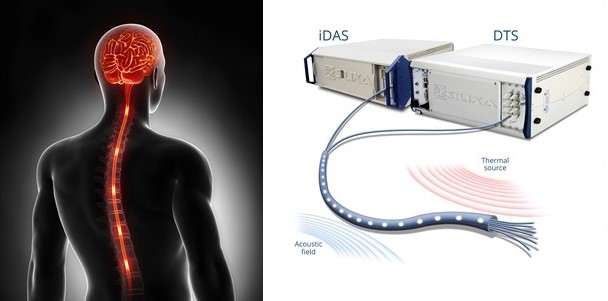DFO is rapidly developing
Unlike the fully grown human nervous system, a rapidly developing technological counterpart is still in its early infancy – Distributed Fibre Optic Sensing (DFO).
In the human body, different cells and organs specialize to perform single tasks optimally. This task distribution is cost-efficient since each single cell can concentrate on a few advanced operations. Coordination throughout the organism requires both a command central and fast, exact communication between the different parts of the body.
In humans, it is the nervous system that safeguards this, with the brain as command central.
How DFO systems work today
Commercial DFO systems today basically consists of a box with electronics called an ‘interrogator’ controlled by a computer, connected to one or a few long (1-100km) fibre optic cables which themselves act as sensors. By analogy the interrogator in DFO acts as brain and the optical fibres mimic distributed nerve fibres (see figure below). Several optical fibres may be mounted on a technical installation. This requires several interrogator units, which can be solved elegantly with parallel opto-electronic circuits.

By programming digital light pulse sequences compiled and run by the interrogator, laser light is transmitted into the optical fibres. By rigorous analysis of the light backscattered from imperfections in the optical fibre material, a myriad of distinct events along the optical fibre can be ‘sensed’ in real-time. Hence the term Distributed Fibre Optic Sensing.
DFO monitoring in O&G asset production
In oil & gas production today, DFO is already a versatile tool in seismic reservoir monitoring, borehole pressure and temperature logging, pipeline leakage detection and more. Fibre optic cables are installed in new wells, on flowlines, risers and pipelines world-wide exploiting the newest developments of the technology for intelligent monitoring.
To our knowledge, many commercial DFO systems available in the market today have axial measurement resolution below 1 meter whilst at the same time covering distances of 10-100 kilometers. It certainly already has become a versatile monitoring tool within the petroleum sector.
The R&D into DFO is continuing and increasing (See figure below). SINTEF assumes that 10-15 capable companies deliver services based on DFO across the world in 2018.

SINTEF’s Multiphase Flow Laboratory at Tiller has accounted sound and has experience with R&D projects from the O&G industry related to DFO over the past 4-5 years.
The intellectual properties of DFO
In my opinion, the intellectual properties of DFO systems lie in the:
- fibre optic cable design & fabrication
- opto-electronic circuit boards
- algorithms controlling the pulsing of light
- data analytics
- deployment details
Both the interrogators and the fibre optic cables themselves are facing novel breakthroughs in the next coming years. The developments will come along the whole value chain from universities, via the institute sector and in a wide variety of small-to-large companies.
Data analytics and online data reduction algorithms will obviously also play a role in next generation DFO systems, as a state-of-the-art DFO system per date easily produces ~10 TB data daily for single oil/gas pipeline monitoring applications in the petroleum sector.
The petroleum sector has used DFO for many years. And based on its generic nature and enabling abilities, DFO also plays an important role today in monitoring of a variety of other man-made constructions across all sectors of society (See the figure below).

Future perspectives on DFO
Light travels ~ 6 orders of magnitude faster than the speed of a typical human nerve signal. The integration of computer algorithms, opto-electronic circuits and data analytics in ‘The DFO brain’ is still far from the human brain in processing capacity. Nevertheless, todays state-of-the-art integrated DFO systems have the great advantage of light speed as information carrier. By taking part in the further development of DFO, SINTEF will contribute to advancing this type technology further – for a better society.
To this end, one can easily imagine that DFO one day may develop into a ‘technical nervous system’. Cognitive functions such as hearing and touch are realized already. SINTEF is pro-active and cross-disciplinary in developing this technology further in concert with collaborating partners.









Comments
No comments yet. Be the first to comment!